Online Friendships: Building Real Bonds in Digital Spaces
You know that feeling when you see a notification from someone who truly gets you? That little spark of excitement when their message pops up on your screen? Maybe they live three time zones away, or on a different continent entirely, but somehow they understand your random 2 AM thoughts better than people you see every day.
That’s the weird magic of online friendships. They’ve quietly become one of the most misunderstood yet powerful types of human relationship – and honestly, most people still don’t get it. Some dismiss them as shallow substitutes for “real” friendship, while others dive in headfirst without considering the genuine complexities involved.
But here’s what I’ve learned from years of nurturing both digital and in-person bonds: online friendships aren’t trying to replace traditional friendship. They’re something entirely different, with their own rules, benefits, and challenges that deserve to be understood on their own terms.
What Makes Digital Friendships Different
Online friendships begin in the strangest places. A comment thread about your favorite obscure band. A gaming session that runs until 3 AM. A support group for people dealing with the same weird health condition you have. There’s no geographical proximity, no shared workplace or school – just two people who somehow clicked through a screen.
The anonymity factor changes everything. People often share their deepest thoughts with internet friends before they’d ever tell their college roommate. There’s something about typing into the void that makes vulnerability easier. You can edit your thoughts, take time to craft responses, and reveal yourself at your own pace.
But it’s not just about anonymity – it’s about finding your tribe. When you live in a small town and nobody understands your passion for medieval history or your struggle with social anxiety, the internet becomes a vast ocean of potential kindred spirits. Geography becomes irrelevant when you’re looking for genuine understanding.
The asynchronous nature of digital communication also changes the game. Your friend in Australia can offer comfort for your breakup at 2 PM their time while you’re crying into your coffee at midnight. The support flows across time zones, creating a 24/7 emotional safety net that physical proximity could never provide.
The Unexpected Benefits Nobody Talks About
Let’s start with the obvious perks: distance doesn’t matter, social anxiety gets a break, and shy people can flourish. But the real benefits run deeper than that.
Digital friendships often skip the small talk phase entirely. When someone reaches out online, it’s usually because they connected with something specific you said or shared. You’re bonding over shared interests or experiences right from the start, which can create surprisingly deep relationships surprisingly fast.
There’s also the editing advantage. In real life, we blurt out things we don’t mean, misread social cues, or get tongue-tied. Online, you can think before you type. You can craft the perfect supportive message for a friend going through a tough time, or carefully explain a complex thought without interruption.
For people dealing with chronic illness, mobility issues, or social anxiety, online friendships can be lifelines. They provide social interaction and emotional support when physical meetups aren’t possible. I’ve seen people build incredible support networks through condition-specific forums or disability communities that simply wouldn’t exist offline.
The cultural exchange aspect is also pretty amazing. Having a close friend who lives in a completely different country gives you perspectives on world events, cultural differences, and daily life that you’d never get otherwise. It’s like having a personal cultural ambassador who actually cares about your understanding.
The Challenges That Keep People Skeptical
But let’s be real – online friendships come with their own baggage. The biggest elephant in the room is deception. People can curate their online personas, hide important details, or outright lie about who they are. That charming friend who seems perfect might be omitting some crucial information about their life.
Misunderstandings happen more frequently too. Without body language, tone of voice, or facial expressions, it’s easy to misinterpret messages. That sarcastic comment might come across as mean. That supportive message might sound patronizing. The nuance of human communication gets lost in translation.
Then there’s the disappearing act problem. Online friends can vanish without warning. One day you’re chatting regularly, and the next day they’ve deleted their account or simply stopped responding. There’s no closure, no explanation – just silence. It’s a unique type of loss that physical friendships rarely experience.
The time zone struggle is real too. When your best internet friend lives 12 hours ahead, finding time for real-time conversations becomes a logistical nightmare. You’re starting your day while they’re ending theirs, and meaningful conversations get relegated to weekend mornings or late-night sessions.
The Psychology of Digital Bonds
What’s fascinating is how our brains process these relationships. Research shows that the emotional connections formed online can be just as powerful as those formed in person. The same brain regions light up when we receive a message from a close online friend as when we interact with physical friends.
The investment of time and emotional energy is often what makes these friendships feel real. When you’ve spent hours talking someone through a crisis, celebrating their achievements, or sharing your own struggles, the relationship develops weight. It stops being casual internet chatter and becomes genuine care.
The shared vulnerability factor is huge. There’s something about the relative safety of online interaction that encourages people to open up faster and more deeply. This accelerated intimacy can create strong bonds quickly, but it can also lead to situations where the relationship feels more intense than it actually is.
The asynchronous nature also allows for more thoughtful communication. You can process what someone shared, think about it, and respond with genuine insight rather than just reacting in the moment. This can lead to deeper, more meaningful exchanges than rapid-fire in-person conversations.
Different Types of Digital Friendships
Not all online friendships are created equal. There’s the gaming buddy who you team up with regularly but know little about their offline life. There’s the forum friend who you’ve had deep philosophical discussions with but couldn’t pick out of a lineup. And there’s the internet bestie who knows your fears, dreams, and daily struggles better than people you see every day.
Interest-based friendships often start in specific communities – art forums, fitness groups, book clubs, or fan communities. These relationships are built around shared passions and can be incredibly fulfilling, even if they never expand beyond that initial common ground.
Support-based friendships often form in more serious spaces – mental health forums, chronic illness groups, or life transition communities. These bonds can be intensely meaningful because they’re forged through shared struggle and mutual aid.
Social media friendships exist in a weird middle ground. You might follow each other’s daily lives through posts and stories, comment regularly, and feel connected, but never have a one-on-one conversation. These relationships can feel intimate because of the constant contact, but they’re often more parasocial than truly mutual.
Making the Transition from Screen to Reality
The question of meeting online friends in person eventually comes up in most meaningful digital relationships. It’s a big step that changes the dynamic entirely. Sometimes the in-person meeting confirms and deepens the online bond. Sometimes it reveals incompatibilities that weren’t apparent through screens.
The key is managing expectations. That person you’ve been chatting with for months is still fundamentally a stranger in physical space. Their mannerisms, voice, and physical presence might be completely different from what you imagined. The chemistry that existed online might not translate to face-to-face interaction.
Safety considerations are paramount when making this transition. Meeting in public places, telling others about your plans, and trusting your instincts are all crucial. The person on the other side of the screen might be exactly who they claimed to be, but they might not be.
Some online friendships are better left in digital space. The relationship works perfectly when mediated by technology but doesn’t need the complexity of physical interaction. There’s nothing wrong with maintaining a purely online friendship if that’s what works for everyone involved.
Building Healthy Digital Relationships
Creating meaningful online friendships requires intentionality. It’s not about collecting followers or maximizing your network – it’s about forming genuine connections with people who enrich your life.
Start by being authentic from the beginning. Don’t create an idealized version of yourself or hide important aspects of your personality. The relationships that form around your real self will be more satisfying and sustainable than those built on a façade.
Respect boundaries and time zones. Just because someone is online doesn’t mean they’re available for deep conversations. Be mindful of the asynchronous nature of digital communication and don’t take delayed responses personally.
Invest in quality over quantity. It’s better to have a few meaningful online friendships than dozens of surface-level connections. Deep relationships require time and emotional energy, whether they’re digital or physical.
Be patient with the natural ebb and flow of online communication. People get busy, lose internet access, or take breaks from social media. Don’t immediately assume friendship is over if someone goes quiet for a while.
When Digital Friendships Go Wrong
Not all online friendships work out, and some can become genuinely problematic. Recognizing red flags is important for protecting your emotional well-being and safety.
Be wary of people who push for personal information too quickly, want to isolate you from other relationships, or seem to have inconsistencies in their stories. Trust is built over time, and anyone pushing for immediate deep intimacy might have ulterior motives.
Emotional manipulation can happen online just as easily as in person. If someone consistently makes you feel guilty for not being available, demands constant attention, or uses emotional crises to control your time and energy, those are warning signs.
The blocking and removing feature exists for a reason. If a digital friendship becomes toxic, unhealthy, or simply runs its course, it’s okay to end it. You don’t owe anyone continued access to your digital space or emotional energy.
Visual Concepts for Understanding Online Friendships
Diagram 1: The Digital Friendship Spectrum A visual representation showing different levels of online relationships, from casual social media interactions to deep digital bonds. This infographic would illustrate how online friendships exist on a spectrum of intimacy and investment, helping readers understand the various types of digital relationships they might encounter.
Diagram 2: The Communication Bridge An illustration showing how different digital platforms facilitate different types of friendships – from gaming platforms that enable team-based bonding to forums that foster interest-based communities to social media that maintains ongoing contact. This would help visualize how the medium shapes the relationship.
Diagram 3: The Time Zone Friendship Map A world map showing how online friendships transcend geographical boundaries, with illustrated time zones and communication flows. This would emphasize the global nature of digital relationships and the unique challenges and benefits of connecting across distances.
The Future of Digital Connection
Technology keeps evolving, and so do online friendships. Virtual reality is creating new possibilities for shared experiences. Video calls are becoming more natural and accessible. AI translation is breaking down language barriers.
But the fundamental human need for understanding, support, and genuine care remains constant. Online friendships fill a specific niche in our social ecosystem – they provide connection without the constraints of geography, social anxiety, or physical limitations.
They’re not replacing traditional friendships; they’re expanding our options for human connection. In a world that’s increasingly divided by politics, geography, and circumstance, the ability to find kindred spirits online is actually pretty remarkable.
The stigma around internet friendships is slowly fading as more people realize these relationships can be just as meaningful as those formed offline. The generation that grew up online doesn’t see digital and physical friendships as fundamentally different – they’re just different types of human connection.
Quick Takeaways
- Online friendships can be just as emotionally meaningful as in-person relationships, with unique benefits like overcoming geographical barriers and social anxiety
- Digital communication allows for more thoughtful responses and accelerated vulnerability, creating deep bonds quickly
- Common challenges include miscommunication, deception risks, and the possibility of friends disappearing without closure
- Different platforms foster different types of relationships, from interest-based communities to support networks
- Meeting online friends in person can be rewarding but requires safety precautions and realistic expectations
- Quality matters more than quantity – focus on building a few meaningful digital relationships rather than collecting connections
- Trust your instincts and maintain boundaries, just as you would in offline relationships
Finding Your Digital Tribe
Here’s the thing about online friendships that nobody really prepares you for: they can sneak up on you. One day you’re just commenting on someone’s post about their cat, and six months later you’re video calling them while they’re having a panic attack at 2 AM.
The magic isn’t in the technology – it’s in the human need for understanding and connection that transcends physical space. When geography, social anxiety, or life circumstances make traditional friendship difficult, the internet offers alternative pathways to meaningful relationships.
But they require the same things all good friendships need: honesty, respect, patience, and genuine care for another person’s well-being. The screen doesn’t change the fundamental requirements of friendship – it just changes the delivery method.
Maybe your online friend will never be someone you grab coffee with on Sunday mornings. Maybe you’ll never meet them in person at all. That doesn’t make the relationship less real or less valuable. It just makes it different.
In a world that often feels increasingly disconnected, the ability to find understanding and support through digital spaces is actually pretty miraculous. The key is approaching these relationships with the same intentionality and care you’d bring to any meaningful friendship.
The person typing on the other side of the screen is just as real as you are. Their struggles, joys, and need for connection are just as valid. When you recognize that simple truth, online friendships stop being a substitute for “real” relationships and become something valuable in their own right.
Frequently Asked Questions
Q: Are online friendships as “real” as in-person friendships? The emotional investment, support, and care in online friendships can be just as genuine as traditional friendships. They’re different, not lesser. The realness comes from the mutual care and understanding, not the delivery method.
Q: How do I know if someone online is being honest about who they are? Look for consistency in their stories over time, be cautious about people who avoid video calls or refuse to share basic information, and trust your instincts if something feels off. Building trust should happen gradually.
Q: Is it safe to meet online friends in person? It can be safe with proper precautions: meet in public places, tell others about your plans, arrange your own transportation, and listen to your gut instincts. Take the same safety measures you’d take meeting any new person.
Q: How do I maintain online friendships when time zones make communication difficult? Be patient with response times, use asynchronous communication methods like voice messages or detailed texts, and schedule regular check-ins when possible. Focus on quality over frequency of contact.
Q: What should I do if an online friendship becomes unhealthy or toxic? Set clear boundaries, limit contact if needed, and don’t hesitate to block or remove someone who consistently makes you feel bad. Online friendships should add positivity to your life, not drain your energy.
Q: Can online friendships help with loneliness and social anxiety? Yes, they can provide valuable social connection and support, though they work best as part of a balanced social life that includes some offline relationships too. They’re great for people who struggle with face-to-face social interaction.
Q: How do I find meaningful online friendships rather than just casual internet acquaintances? Join communities based on your genuine interests or experiences, engage authentically rather than trying to impress, and invest time in getting to know people who seem genuinely interested in mutual friendship rather than just networking.



